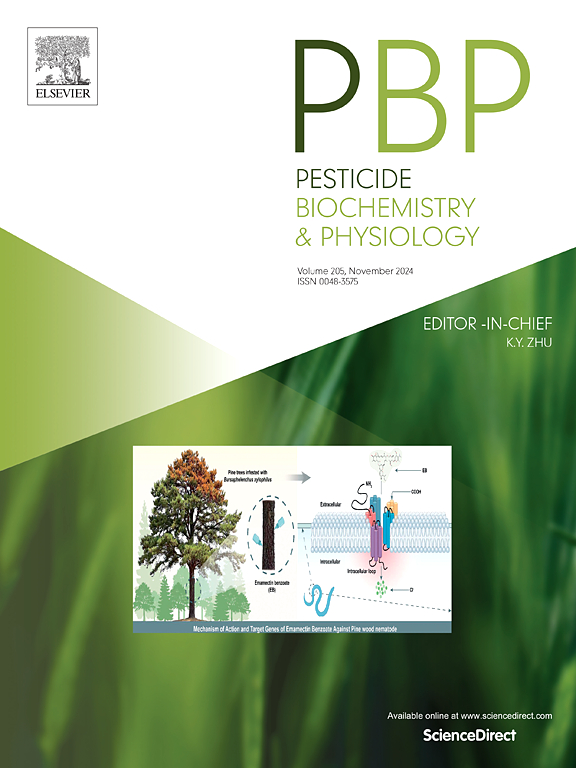ROS acted as an initial role in selenium nanoparticles alleviating insecticide chlorpyrifos-induced oxidative stress, pyroptosis, and intestinal barrier dysfunction in porcine intestinal epithelial cells
IF 4.2
1区 农林科学
Q2 BIOCHEMISTRY & MOLECULAR BIOLOGY
引用次数: 0
Abstract
Chlorpyrifos (CPF), a toxic organophosphorus insecticide, is widely used in agriculture to protect crops (eg., maize) from pests. The use of CPF in crops can result in accumulation in crop seeds, such as corn seeds, which is a primary feed ingredient in pigs. Pigs in China, which is an important source of animal-derived protein in the Chinese diet, account for over 50 % of the raised pig population in the whole world. Therefore, CPF may pose a potential risk to the health of non-target organisms (pigs and humans) through the food chain. However, whether CPF can damage porcine intestine remains unknown. Selenium (Se), an essential trace element, was reported to have antioxidant and anti-toxic effects. Tight junction (TJ) is an important mechanism of intestinal injury and pyroptosis is a new hotspot in the field of toxicology. Hence, we wanted to investigate whether CPF can damage pig intestine and whether selenium nanoparticles (SeNPs) supplement can alleviate CPF-induced pig intestine damage, and to study corresponding mechanism from the three aspects of OS, pytoptosis, and TJ. We established a model of SeNPs alleviating damage caused by CPF in intestinal porcine enterocytes (IPEC-J2 cells), and found that SeNPs alleviated CPF-induced oxidative stress (OS), pyroptosis, and intestinal barrier dysfunction in IPEC-J2 cells. Interestingly, OS, pyroptosis, and intestinal barrier dysfunction had serial relations, and ROS/Nrf2/Caspase-1/Occludin and ROS/Nrf2/Caspase-1/ZO-1 pathways played a role. Notably, ROS and Caspase-1 played an initial and important role, respectively. Our study added new information on pesticides-caused damage to non-target organisms, and provided new idea, insight, and targets to mitigatie pesticides-induced toxic effect on non-target organisms.

活性氧在硒纳米颗粒缓解杀虫剂毒死蜱诱导的猪肠上皮细胞氧化应激、焦亡和肠屏障功能障碍中起初步作用
毒死蜱(CPF)是一种有毒的有机磷杀虫剂,在农业中广泛用于保护作物(如玉米)。(玉米)免受虫害。在作物中使用CPF可导致作物种子积累,如玉米种子,这是猪的主要饲料成分。中国的猪是中国人饮食中动物性蛋白质的重要来源,占世界养猪存栏量的50%以上。因此,CPF可能通过食物链对非目标生物(猪和人)的健康构成潜在风险。然而,CPF是否会损害猪的肠道仍是未知的。硒(Se)是人体必需的微量元素,具有抗氧化和抗毒性作用。紧密结(Tight junction, TJ)是肠道损伤的重要机制,焦亡是毒理学研究的新热点。因此,我们想研究CPF是否会对猪肠道造成损伤,以及补充硒纳米粒子(SeNPs)是否能减轻CPF诱导的猪肠道损伤,并从OS、pytoptosis和TJ三个方面研究相应的机制。我们建立了SeNPs减轻CPF对猪肠细胞(IPEC-J2细胞)损伤的模型,发现SeNPs可以减轻CPF诱导的IPEC-J2细胞氧化应激(OS)、焦亡和肠屏障功能障碍。有趣的是,OS、焦亡和肠屏障功能障碍具有系列关系,ROS/Nrf2/Caspase-1/Occludin和ROS/Nrf2/Caspase-1/ZO-1通路起作用。值得注意的是,ROS和Caspase-1分别发挥了初始和重要的作用。本研究为农药对非靶生物的危害研究提供了新信息,为减轻农药对非靶生物的毒性作用提供了新思路、新见解和新靶点。
本文章由计算机程序翻译,如有差异,请以英文原文为准。
求助全文
约1分钟内获得全文
求助全文
来源期刊
CiteScore
7.00
自引率
8.50%
发文量
238
审稿时长
4.2 months
期刊介绍:
Pesticide Biochemistry and Physiology publishes original scientific articles pertaining to the mode of action of plant protection agents such as insecticides, fungicides, herbicides, and similar compounds, including nonlethal pest control agents, biosynthesis of pheromones, hormones, and plant resistance agents. Manuscripts may include a biochemical, physiological, or molecular study for an understanding of comparative toxicology or selective toxicity of both target and nontarget organisms. Particular interest will be given to studies on the molecular biology of pest control, toxicology, and pesticide resistance.
Research Areas Emphasized Include the Biochemistry and Physiology of:
• Comparative toxicity
• Mode of action
• Pathophysiology
• Plant growth regulators
• Resistance
• Other effects of pesticides on both parasites and hosts.

 求助内容:
求助内容: 应助结果提醒方式:
应助结果提醒方式:


